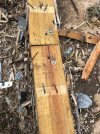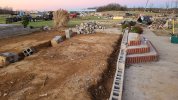I bet if we looked specifically for concrete/cmu/masonry structures that were blown away. We'd find a lot more 200 mph evidence than just anchor bolts. That's certainly the case in Mayfield.If I recall, it was just after 2011.
Navigation
Install the app
How to install the app on iOS
Follow along with the video below to see how to install our site as a web app on your home screen.
Note: This feature may not be available in some browsers.
More options
-
Welcome to TalkWeather! We see you lurking around TalkWeather! Take the extra step and join us today to view attachments, see less ads and maybe even join the discussion. CLICK TO JOIN TALKWEATHER
You are using an out of date browser. It may not display this or other websites correctly.
You should upgrade or use an alternative browser.
You should upgrade or use an alternative browser.
AJS
Member
I’m gonna be completely honest, the amount of bad construction along the path of the Mayfield tornado was overwhelming. Some spots had decent/good construction though like @buckeye05 mentioned about Cambridge Shores.I bet if we looked specifically for concrete/cmu/masonry structures that were blown away. We'd find a lot more 200 mph evidence than just anchor bolts. That's certainly the case in Mayfield.
I have looked at numerous videos/images of the damage from Cambridge Shores and while the damage to homes was impressive and lot of pretty well constructed homes were swept away, the overall area did not have “ the look “ to it. Now I do agree 170 mph was too low for that location was there was some pretty severe tree debarking and some moderately intense vehicle damage so I do believe 180-190 would be more appropriate for Cambridge Shores.
We've been over this. CMU houses ARE well constructed. They're better than wood frame. The widespread accepted belief that they're weak is a myth.I’m gonna be completely honest, the amount of bad construction along the path of the Mayfield tornado was overwhelming. Some spots had decent/good construction though like @buckeye05 mentioned about Cambridge Shores.
I have looked at numerous videos/images of the damage from Cambridge Shores and while the damage to homes was impressive and lot of pretty well constructed homes were swept away, the overall area did not have “ the look “ to it. Now I do agree 170 mph was too low for that location was there was some pretty severe tree debarking and some moderately intense vehicle damage so I do believe 180-190 would be more appropriate for Cambridge Shores.
Also Cambridge shores was never adequately surveyed. Almost all the pictures in the DAT were taken from a moving vehicle. I bet the surveyors heard about the University of Kentucky research center being hit and were in a rush to get there. It's directly after Cambridge shores in the damage path. From there, they seem to slow down and survey a little more in depth.
Then Bremen had two CMU/stone houses that were dissapeared.
AJS
Member
I definitely hear what you are saying btw.We've been over this. CMU houses ARE well constructed. They're better than wood frame. The widespread accepted belief that they're weak is a myth.
Also Cambridge shores was never adequately surveyed. Almost all the pictures in the DAT were taken from a moving vehicle. I bet the surveyors heard about the University of Kentucky research center being hit and were in a rush to get there. It's directly after Cambridge shores in the damage path. From there, they seem to slow down and survey a little more in depth.
Then Bremen had two CMU/stone houses that were dissapeared.
What I was implying was that the construction quality along the path excluding CMU homes was overwhelming.
And I agree that the survey in Cambridge Shores was quite poor. It definitely wasn’t as detailed and thorough as it should’ve been. I don’t give PAH a hard time though about it because of the tremendous path they had to survey.
If you’re talking about houses where the actual walls are CMU and reinforcement is present (critical distinction), yes that’s accurate. But when it comes to the topic of CMU in relation to poor house construction and lowered ratings, you’re misunderstanding what is being referenced by the NWS, which is wood-frame homes built atop CMU foundations, vs poured concrete foundations.We've been over this. CMU houses ARE well constructed. They're better than wood frame. The widespread accepted belief that they're weak is a myth.
Also Cambridge shores was never adequately surveyed. Almost all the pictures in the DAT were taken from a moving vehicle. I bet the surveyors heard about the University of Kentucky research center being hit and were in a rush to get there. It's directly after Cambridge shores in the damage path. From there, they seem to slow down and survey a little more in depth.
Then Bremen had two CMU/stone houses that were dissapeared.
When you see “CMU house” or some variation of that phrase in damage survey notes, that’s in reference to the foundation type 95% of the time, not the structure itself. CMU foundations are absolutely a weak point that can justifiably lead to lower ratings. This is because as the wind hits the house, the mortar between the blocks can crack, and the blocks shift or pull away from the rest of the foundation, causing the foundation itself to fail underneath the anchor bolts. So when it comes to house foundations, it’s certainly no “myth” that CMU is weaker than poured concrete. The only exception is if the cells within the foundation blocks are completely filled in and reinforcements are added, which is quite rare. If you’re seeing CMU foundations in the DAT or referenced in text surveys and assuming that means the rest of the structure in question was also of masonry construction, you’re operating under a big misconception.
Also I could be wrong, but I am not aware of any stone/masonry-frame homes being obliterated in Bremen. Happy to be proven otherwise though.
Last edited:
AJS
Member
I think one of the houses he may be talking about is the 190 MPH DI. But I don’t recall that being a stone/masonry house. From what I remember it was a very oddly constructed house.If you’re talking about houses where the actual walls are CMU and reinforcement is present (critical distinction), yes that’s accurate. But when it comes to the topic of CMU in relation to poor house construction and lowered ratings, you’re misunderstanding what is being referenced, which is wood-frame homes built atop CMU foundations, vs poured concrete foundations.
When you see “CMU house” or some variation of that phrase in damage survey notes, that’s in reference to the foundation type 99% of the time, not the structure itself. CMU foundations are absolutely a weak point that can justifiably lead to lower ratings. This is because as the wind hits the house, the mortar between the blocks can crack, and the blocks shift or pull away from the rest of the foundation, causing the foundation itself to fail underneath the anchor bolts. So when it comes to house foundations, it’s certainly no “myth” that CMU is weaker than poured concrete. The only exception is if the cells within the foundation blocks are completely filled in and reinforcements are added, which is quite rare. If you’re seeing CMU foundations in the DAT or referenced in text surveys and assuming that means the structure in question was a masonry construction house, that’s a big misconception.
Also I could be wrong, but I am not aware of any stone/masonry-frame homes being obliterated in Bremen. Happy to be proven otherwise though.
Also at face value, masonry homes can absolutely be weaker than wood frame homes. Unreinforced CMU walls have a failure point in the within the EF1 range. That’s why reinforced vs unreinforced CMU is a critical distinction. It’s also why you see weaker tornadoes knocking down cinder block exterior walls at warehouses, schools, and big box stores. It’s also why you see total destruction of villages from lower-end tornadoes in parts of Africa/Asia/South America. Housing in poorer parts of those continents frequently use unreinforced CMU construction.
Yeah I’ve seen a “before” pic. It was a wood frame house with metal panel siding.I think one of the houses he may be talking about is the 190 MPH DI. But I don’t recall that being a stone/masonry house. From what I remember it was a very oddly constructed house.
Regardless, the main point I’m making is that when the NWS cites CMU as a reason to go with a lower rating at a house, that’s almost always in reference to the foundation type. There’s no collective NWS agreement that masonry-frame homes are weaker, unless they aren’t reinforced. Plus, masonry-frame homes are not common in the US, and rarely even come up as DIs in surveys.
Last edited:
AJS
Member
- Messages
- 4,603
- Reaction score
- 9,482
- Location
- California, United States
- Special Affiliations
- SKYWARN® Volunteer
1. Please don't use generative AI as one of your sources...I have a question... When exactly did the NWS decide houses built out of CMU were weak, and why are concrete/masonry houses being rated the same or worse as wood frame houses, regardless of anchoring?
View attachment 37333
A well anchored wood frame house isn't even comparable to CMU or concrete... Yet, wood is the only DI houses have in the EF scale. Concrete and masonry construction were central pillars for uncovering F4 and F5 wind speed in the original scale, but in the EF scale they're not.
View attachment 37334
Here are all the major wood frame DIs and their maximum "expected" wind speeds (** - no concrete/CMU indicator):
1.** One or two family residence - 200 mph
2. Apt, condo, townhouse (3 stories or less) - 180 mph (top two stories destroyed)
3. Motels - 190 mph
4.** Small retail bldg. (fast food) - 167 mph
5.** Small professional (doctor office, branch bank) - 157 mph
Here are metal and steel frame buildings:
1.** Automobile showroom - 157 mph
2.** Warehouses, industrial facilities, arenas - 155 mph
3.** Large shopping mall - 204 mph
4.** Storage and Industrial buildings - 158 mph
Here are concrete/masonry/CMU buildings:
1. Masonry Apartments or Motels - 156 mph (top two stories destroyed) 180 mph (total destruction)
2. Strip mall - 171 mph
3. Large, isolated ("big box") retail building - 173 mph
4. Elementary School - 176 mph
Reinforced Concrete buildings
1. Junior and Senior High School - 192 mph
2. Low-rise (1-4 story)(reinforced concrete) - 188 mph
3. Mid-rise (5-20 story) - 210 mph
4. High-rise (over 20 stories) - 228 mph
5. Institutional bldg. (hospital, govt. or university) - 210 mph
So let me get this straight... DIs for the most common structures are all wood frame, have the higher expected wind speeds than concrete/masonry/CMU, and all the concrete/masonry/CMU DIs are reserved for only large open faced buildings?
I can't believe I've never seen this before. This scale is deliberately DESIGNED to fail at uncovering EF5 wind speeds. The average maximum exp windspeed for concrete/CMU is 169 MPH. For wood framed structures its 179 mph. Even steel framed buildings have a lower average than wood frame at 171 mph. It makes no sense. It's not even a good engineering scale. We haven't gotten lucky with "tornadoes missing strong structures". Tornadoes are hitting strong structures, but there isn't a way to measure it!!!
2. Masonry doesn't automatically equal better construction, especially in larger buildings. If anything, unreinforced masonry is actually worse in tornadoes (and earthquakes - ask me how I know) than anchored wood framing. Reinforced masonry is a different story, though.
3. There's no evidence that 'the NWS decided homes built out of CMU were weak'. What you're seeing is a scale adjusted to the fact that most homes in the US are wood framed.
Aaron Rider
Member
Arkansas is a poor state but a state with TRUE GRIT, in my opinion, having been there. Hell, that's where the author of True Grit (Charles Portis) was from. This seems like a tough, good lady and I wish her well.Is it just me or does this make it look like Tim made up his story and the house was only half built when it was hit? I get the person claiming to be the owner could be lying as well, but the implications if she's not are pretty damn serious. The post has over 1500 shares so I won't be able to verify her identity for a while. I saw it posted on Reddit.
Edit:
Tim's post is basically viral now with 1700 shares. found the homeowner. Her post is public and anyone can find it so I won't censor her name. She's devasted. Her and others reached out to him and he has since turned off comments on his posts but hasn't deleted or rescinded any of his own tasteless comments.
View attachment 37035View attachment 37036View attachment 37037View attachment 37038View attachment 37039View attachment 37040View attachment 37041View attachment 37042View attachment 37043View attachment 37044
Aaron Rider
Member
It's a "excrement sandwich" in the sense that it requires EXHAUSTIVE research. Guys like Loco, via his blog, have done an utterly amazing job of analyzing the heck out of outbreaks. For example, I feel we can rate the tornadoes of 5/31/85 or 4/11/65 pretty darned confidently just based on the work many have put in.Hot Takes incoming:
Sayler park would be an EF3 to Low End EF4 candidate. DePauw was so rural that it most likely would be an EF4 too. It never probably hit anything substantially well built that would pass muster today.
You would be hard pressed to find well built homes in the south, especially in the areas near Guin. While Guin should be a slam dunk, I really don’t know if it gets a 5 post-2013 EF scale just because of the construction quality impacted. You also had sharp damage gradients that any John Robinson type would use to justify not giving it a 5.
Xenia MAY get a 5 today.
To me, Brandenburg would be your almost sure EF5. Comparing historical outbreaks to today is now just a excrement sandwich, so it doesn’t really matter anyway.
So I think it can still be done. Where the real issue comes in is with the fact that we now exhaustively account for even smaller tornadoes, whereas, with past outbreaks, much of our records revolve around only the more or most significant ones.
Aaron Rider
Member
Came across an interesting and potentially underrated tornado from the 2011 Super Outbreak and it got me thinking about how aircraft behave in tornadoes. It struck the Potomac Airfield near Friendly, MD and damaged six small aircraft, with one Cessna 182 being thrown 125 feet and a Cessna 335 being tossed about 25 feet. It was given a rating of EF0.
Another example of such a tornado struck the Fairfield Co. Airport in SC on May 4, 2021, tossing a Beechcraft Sundowner 100 yards and ripping off one of its wings in the process. This storm was given an EF1 rating.
As far as larger aircraft go, a few obvious examples are the 1948 Tinker AFB tornadoes that "destroyed" B-54's, B-29's and DC-3's, but I don't know off the top of my head how many of those (if any) were actually moved/tossed a considerable distance in addition to the structural damage sustained. These tornadoes are rated F3.
The last example I'll touch up on is the 1979 Windsor Locks tornado. Don't know the exact aircraft type here, but this cargo plane reportedly weighed 100 tons and was actually flipped over and snapped into three pieces. Probably the most impressive of all the examples:


But that brings me back to my original question: were these tornadoes (particularly the 2011 and 2021 events) rated appropriately? Even general aviation aircraft are obviously not "light" per say (a Cessna 182 comes in at just over 1,600 lbs) but still weigh significantly less than an average car and are obviously designed to be aerodynamic, so they behave weirdly in tornadoes. Whether or not an aircraft is tied down might also make a difference, though in both the Potomac and Fairfield tornadoes they were and it obviously didn't help much.
Even the Tinker AFB tornado is a bit of a head-scratcher. The aforementioned large aircraft obviously weighed much more than an average car, but it's again a weird case due to how aircraft are designed, which theoretically may cause them to "catch" the wind with relative ease. Needless to say I don't disagree with the F3 ratings here, but the process of determining an F or EF rating using damage to aircraft is a process I don't understand tbh.
The one case I can confidently say is indicative of violent winds is the Windsor Locks tornado. Again, a plane is obviously going to be much more aerodynamic than something like a battle tank, but the fact that it weighed 100 tons and the fuselage was actually snapped in places - that's impressive stuff.
What are your guys' thoughts on this?
Regarding Windsor Locks, I remembered reading about it in the Significant Tornadoes thread, specifically about how at least one of the homes it destroyed was anchor bolted. Here's the post, but guess who posted it? You yourself! https://talkweather.com/threads/significant-tornado-events.1276/post-130445
I think it has a strong post-facto argument for F5! Which, considering the time (October!) and place (Connecticut!!), is wild! Wilder, even, than the Worcester tornado, I think! Didn't this thing also have some strange deviant due north direction?
- Messages
- 4,603
- Reaction score
- 9,482
- Location
- California, United States
- Special Affiliations
- SKYWARN® Volunteer
Yeah, the intensity of Windsor Locks is something I’ve brought up before. In short, high end F4 is fine but a strong case for F5 can be made, and if it were up to me I’d probably side with a low-end F5 rating tbh.Regarding Windsor Locks, I remembered reading about it in the Significant Tornadoes thread, specifically about how at least one of the homes it destroyed was anchor bolted. Here's the post, but guess who posted it? You yourself! https://talkweather.com/threads/significant-tornado-events.1276/post-130445
I think it has a strong post-facto argument for F5! Which, considering the time (October!) and place (Connecticut!!), is wild! Wilder, even, than the Worcester tornado, I think! Didn't this thing also have some strange deviant due north direction?
Honestly, it’s just as strong of a contender for the strongest tornado in the northeastern states as Worcester - the main difference between the two is that Worcester produced many areas of probable F5 damage while Windsor Locks’ peak intensity was relatively confined to a few streets and the Bradley Air Museum.
Also yes, the Windsor Locks tornado moved almost due north - an unusual path for a tornado, especially for one as violent as it was.
If you’re talking about houses where the actual walls are CMU and reinforcement is present (critical distinction), yes that’s accurate. But when it comes to the topic of CMU in relation to poor house construction and lowered ratings, you’re misunderstanding what is being referenced by the NWS, which is wood-frame homes built atop CMU foundations, vs poured concrete foundations.
I'm talking about structures built entirely out of CMU, concrete block, or poured concrete.
3. There's no evidence that 'the NWS decided homes built out of CMU were weak'. What you're seeing is a scale adjusted to the fact that most homes in the US are wood framed.
It's important to note the vagueness of the original F scale was almost a benefit when it came to analyzing concrete and CMU construction. The problem with the EF scale is that for most DIs, the wind speed estimates were based on wood frame or steel frame (with metal panels) construction, and surveyors haven't been taught to make any distinctions for concrete or CMU.
There's enough houses, apartments, townhomes, retail buildings, doctors offices, banks, warehouses, and arenas built out of concrete, CMU, or masonry that not having them in the scale is a critical missing piece. The only times CMU or masonry make an appearance in the scale is for structures with huge, broad walls or large storefront windows, so the structural benefit isn't nearly as applicable. That feels like an intentional omission to me, and makes it MUCH harder to determine EF5 winds.
Based on my Mayfield analysis, It seems reinforced CMU is treated almost the same as unreinforced, and the intensity of destruction to both (simply in regards to the sheer weight involved) isn't even analyzed in a coherent manner.
It's also important to note, based on my research of the dollar general in Matador, that there's a huge variety in metal building systems. A lot of the most prominent retail contractors use "certified metal building systems" which are rated to withstand winds of 150 mph+ (a category 5 hurricane). Surveyors aren't taught about this, so many MBSs are significantly underrated.
Posting what i've found now. This is across the entire damage path and a lot of the pics are hard to determine construction quality because of the intensity of destruction or lack of good quality pictures. I'll number them so if you see any you specifically want to call out it'll be easier.Also I could be wrong, but I am not aware of any stone/masonry-frame homes being obliterated in Bremen. Happy to be proven otherwise though.
12. Possible concrete block home destroyed
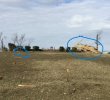
13. Concrete block home swept clean (fridge in a tree top right as well lol)

14. Steel reinforced concrete and masonry low rise building

15. Masonry institutional building classified as "elementary school" EF3

16. Complete destruction of retail building with CMU being the only building material visible

17. Concrete institutional building classified as "Elementary school" #2. rated EF3

18. Concrete block or stone home destroyed


19. hard to tell what's going on here, but the DAT described it as "concrete home gone"

20. Mayfield courthouse. Institutional building with "significant damage to building envelope". Whole building was compromised and had to be demolished.


13. Concrete block home swept clean (fridge in a tree top right as well lol)

14. Steel reinforced concrete and masonry low rise building

15. Masonry institutional building classified as "elementary school" EF3

16. Complete destruction of retail building with CMU being the only building material visible

17. Concrete institutional building classified as "Elementary school" #2. rated EF3

18. Concrete block or stone home destroyed


19. hard to tell what's going on here, but the DAT described it as "concrete home gone"

20. Mayfield courthouse. Institutional building with "significant damage to building envelope". Whole building was compromised and had to be demolished.

21. Heavily steel reinforced masonry building destroyed.

22. CMU house destroyed with 55 foot oil tankers that were rolled over 20 yards, a full coal car completely stripped and flipped, and multiple fully debarked trees. talk about contextuals...
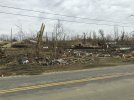
23. Steel reinforced, with reinforced CMU elementary school. This is incredibly impressive damage, so i'm gonna post a lot of pics. Was only rated EF3.

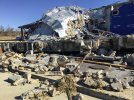







22. CMU house destroyed with 55 foot oil tankers that were rolled over 20 yards, a full coal car completely stripped and flipped, and multiple fully debarked trees. talk about contextuals...

23. Steel reinforced, with reinforced CMU elementary school. This is incredibly impressive damage, so i'm gonna post a lot of pics. Was only rated EF3.











